Controlling Variability in Mechanical Properties of Plates by Reducing Centerline Segregation to Meet Strain-Based Design of Pipeline Steel
Abstract
:1. Introduction
2. Materials and Methods
3. Results
3.1. Segregation Evaluation of Slabs
3.2. Low Temperature Toughness
3.3. Tensile Properties
3.4. Microstructure in Segregated Region
3.5. Enrichment of Elements in Segregated Region
4. Discussion
4.1. Influence of Degree of Segregation on the Microstructure
4.2. Relationship between Microstructure and Variability on Mechanical Properties
5. Conclusions
- (1)
- The relationship between the degree of centerline segregation and mechanical properties indicates that controlling the centerline segregation of continuous casting slab can achieve the requirements of a strain-based design, such as small fluctuations in strength, low yield ratio, high elongation, and better toughness at low temperatures;
- (2)
- As the degree of centerline segregation increases, impact energy decreases gradually and DBTT increases. Meanwhile, the variability in impact toughness becomes larger, especially when the degree of segregation exceeds Mannesmann class 2; i.e., at −60 °C, the variability range in toughness (~75 J) of plate A (segregation degree higher than class 2) was higher than plate B (~40 J, segregation degree almost at class 2); at −80 °C, the variability range in toughness of plate A (~260 J) is higher than plate B (~75 J);
- (3)
- With an increase in the degree of segregation, the tensile and yield strength increased; elongation decreased, the variability in strength increased. When the degree of centerline segregation is higher than the Mannesmann class 2, the variability range of tensile strength ranges from ~13 MPa to ~110 MPa;
- (4)
- When the degree of centerline segregation in the continuous casting slab exceeds the Mannesmann class 2, the microstructure in the centerline of the corresponding rolling plate is transformed from ferrite and pearlite into bainite/martensite.
Author Contributions
Funding
Acknowledgments
Conflicts of Interest
References
- Macia, M.L.; Kibey, S.A.; Arslan, H. Approaches to Qualify Strain-Based Design Pipelines. In Proceedings of the 8th International Pipeline Conference, American Society of Mechanical Engineers, Calgary, AB, Canada, 27 September–1 October 2010; pp. 365–374. [Google Scholar]
- Zhou, J.; Horsley, D.; Rothwell, B. Application of strain-based design for pipelines in permafrost areas. In Proceedings of the 2006 International Pipeline Conference. American Society of Mechanical Engineers, Calgary, AB, Canada, 25–29 September 2006; pp. 899–907. [Google Scholar]
- Liu, B.; Liu, X.J.; Zhang, H.J. Strain-based design criteria of pipelines. J. Loss Prev. Proc. 2009, 22, 884–888. [Google Scholar] [CrossRef]
- Beckermann, C. Macrosegregation ASM Handbook; American Society of Metals: Geauga County, OH, USA, 2008; Volume 15, pp. 4733–4738. [Google Scholar]
- Flemings, M.C. Our understanding of macrosegregation: Past and present. ISIJ Int. 2000, 40, 833–841. [Google Scholar] [CrossRef]
- Fujda, M. Centerline segregation of continuously cast slabs influence on microstructure and fracture morphology. J. Metal Mater. Miner. 2005, 15, 45–51. [Google Scholar]
- Ueyama, S.; Niizuma, M.; Yonezawa, K. Development of High Quality Heavy Plates on Steelmaking Process at Kimitsu Works. Nippon Steel Tech. Rep. 2013, 104, 102–108. [Google Scholar]
- Bor, A.S. Effect of pearlite banding on mechanical properties of hot-rolled steel plates. ISIJ Int. 1991, 31, 1445–1446. [Google Scholar] [CrossRef]
- Osamu, H.; Hidenari, K.; Yasuhiro, H.; Setsuo, K.; Hajime, B.; Shoji, S. Macro-and semi-macroscopic features of the centerline segregation in CC slabs and their effect on product quality. ISIJ Int. 1984, 24, 891–898. [Google Scholar]
- Mendoza, R.; Alanis, M.; Perez, R.; Alvarez, O.; Gonzalez, C.; Juarez-Islas, J.A. On the processing of Fe–C–Mn–Nb steels to produce plates for pipelines with sour gas resistance. Mater. Sci. Eng. A 2002, 337, 115–120. [Google Scholar] [CrossRef]
- Lin, B.Y.; Chen, E.T.; Lei, T.S. The effect of segregation on the austemper transformation and toughness of ductile irons. J. Mater. Eng. Perform. 1998, 7, 407–419. [Google Scholar] [CrossRef]
- Tushal, K.; Shant, J.R.; Rajesh, K.G.; Kathayat, T.S. Understanding the Delamination and Its Effect on Charpy Impact Energy in Thick Wall Linepipe Steel. J. Mater. Metall. Eng. 2014, 4, 31–39. [Google Scholar]
- Bhattacharya, D.; Roy, T.K.; Mahashabde, V.V. A study to establish correlation between intercolumnar cracks in slabs and off-center defects in hot-rolled products. J. Fail. Anal. Prev. 2016, 16, 95–103. [Google Scholar] [CrossRef]
- Loucif, A.; Fredj, E.B.; Harris, N.; Shahriari, D.; Jahazi, M.; Lapierre-Boire, L.-P. Evolution of A-type macrosegregation in large size steel ingot after multistep forging and heat treatment. Metall. Mater. Trans. B 2018, 49, 1046–1055. [Google Scholar] [CrossRef]
- Tao, J.; Hu, S.; Yan, F.; Zhang, Y.; Langley, M. A study of the mechanism of delamination fracture in bainitic magnetic yoke steel. Mater. Des. 2016, 108, 429–439. [Google Scholar] [CrossRef]
- Zhang, G.; Yang, X.; He, X.; Li, J.; Hu, H. Enhancement of mechanical properties and failure mechanism of electron beam welded 300M ultrahigh strength steel joints. Mater. Des. 2013, 45, 56–66. [Google Scholar] [CrossRef]
- Ji, Y.; Lan, P.; Geng, H.; He, Q.; Shang, C.; Zhang, J. Behavior of Spot Segregation in Continuously Cast Blooms and the Resulting Segregated Band in Oil Pipe Steels. Steel Res. Int. 2018, 89, 1700331. [Google Scholar] [CrossRef]
- Su, L.; Li, H. The assessment of centreline segregation in continuously cast line pipe steel slabs using image analysis. In Proceedings of the 6th International Pipeline Technology Conference, American Society of Mechanical Engineers Ostend, Ostend, Belgium, 7–9 October 2013; Volume 1. [Google Scholar]
- Collins, L.E. Effects of Segregation on the Mechanical Performance of X70 Line Pipe. In Proceedings of the 11th International Pipeline Conference, American Society of Mechanical Engineers, Calgary, AB, Canada, 26–30 September 2016; Volume 1. [Google Scholar]
- Guo, F.; Wang, X.; Liu, W.; Shang, C.; Misra, R.D.K.; Wang, H.; Zhao, T.; Peng, C. The Influence of Centerline Segregation on the Mechanical Performance and Microstructure of X70 Pipeline Steel. Steel Res. Int. 2018, 89, 1800407. [Google Scholar] [CrossRef]
- No. SN 960: 2009. Classification of Defects in Materials-Standard Charts and Sample Guide; SMS Demag AG Mannesmann: Düsseldorf, Germany, 2009. [Google Scholar]
- Nayak, S.S.; Misra, R.D.K.; Hartmann, J.; Siciliano, F.; Gray, J.M. Microstructure and properties of low manganese and niobium containing HIC pipeline steel. Mater. Sci. Eng. A 2008, 494, 456–463. [Google Scholar] [CrossRef]
- Su, L.; Li, H.; Lu, C.; Li, J.; Fletcher, L.; Simpson, I.; Barbaro, F.J.; Zheng, L.; Bai, M.; Shen, J.; et al. Transverse and z-direction CVN impact tests of X65 line pipe steels of two centerline segregation ratings. Metall. Mater. Tran. A 2016, 47, 3919–3932. [Google Scholar] [CrossRef]
- Bhattacharya, D.; Poddar, G.P.; Misra, S. Centreline defects in strips produced through thin slab casting and rolling. Mater. Sci. Tech. 2016, 32, 1354–1365. [Google Scholar] [CrossRef]
- Lee, H.; Jo, M.C.; Sohn, S.S.; Zargaran, A.; Ryu, J.H.; Kim, N.J.; Lee, S. Novel medium-Mn (austenite + martensite) duplex hot-rolled steel achieving 1.6 GPa strength with 20% ductility by Mn-segregation-induced TRIP mechanism. Acta Mater. 2018, 147, 247–260. [Google Scholar] [CrossRef]
- Mukherjee, M.; Chintha, A.R.; Kundu, S.; Misra, S.; Singh, J.; Bhanu, C.; Venugopalan, T. Development of stretch flangeable ferrite–bainite grades through thin slab casting and rolling. Mater. Sci. Tech. 2016, 32, 348–355. [Google Scholar] [CrossRef]
- Zhang, H.; Cheng, X.; Bai, B.; Fang, H. The tempering behavior of granular structure in a Mn-series low carbon steel. Mater. Sci. Eng. A 2011, 528, 920–924. [Google Scholar] [CrossRef]
- Feng, R. Research on Internal Quality and Its Influencing Factors of Ferrite/Pearlite Steel Plate. Ph.D. Thesis, Shandong University, Shandong, China, 30 October 2013. [Google Scholar]
- DNV-OS-F101: 2000. Offshore Standard Submarine Pipeline Design; Det Norske, Veritas: Oslo, Norway, 2000. [Google Scholar]
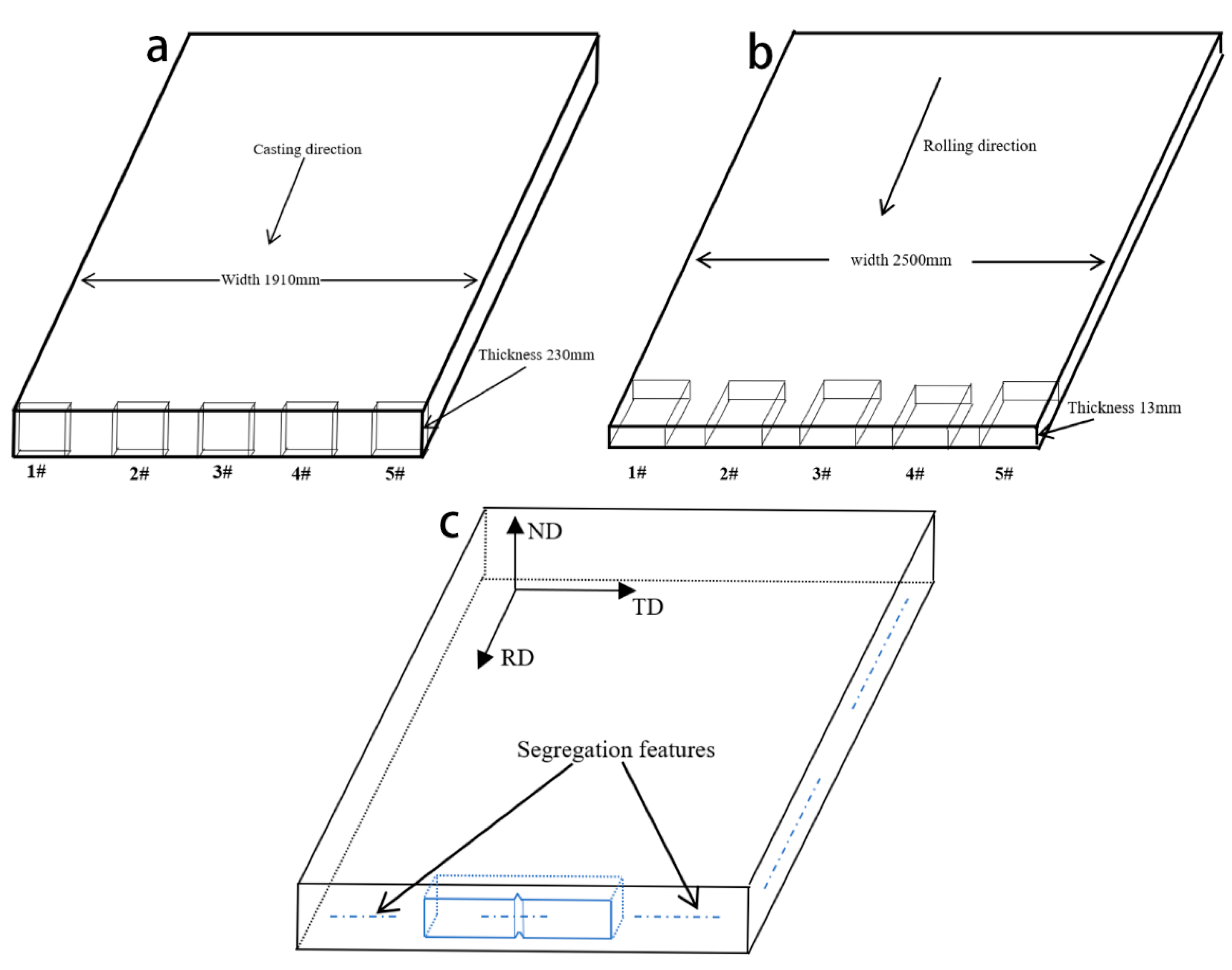
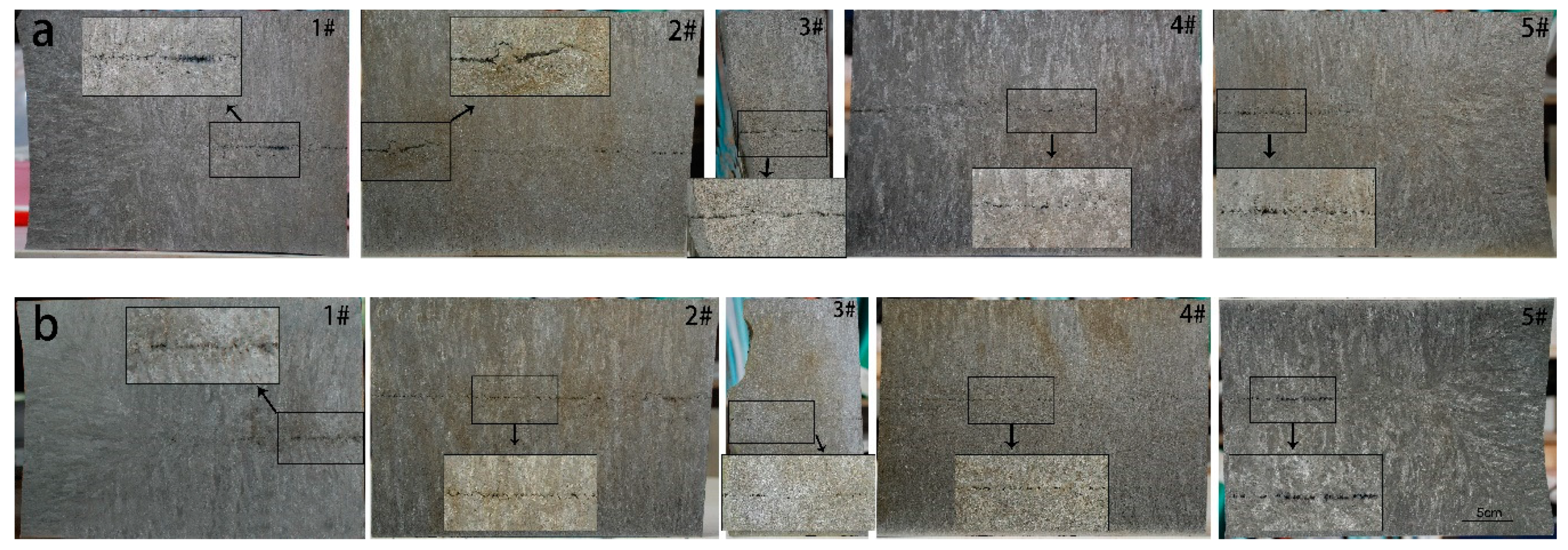
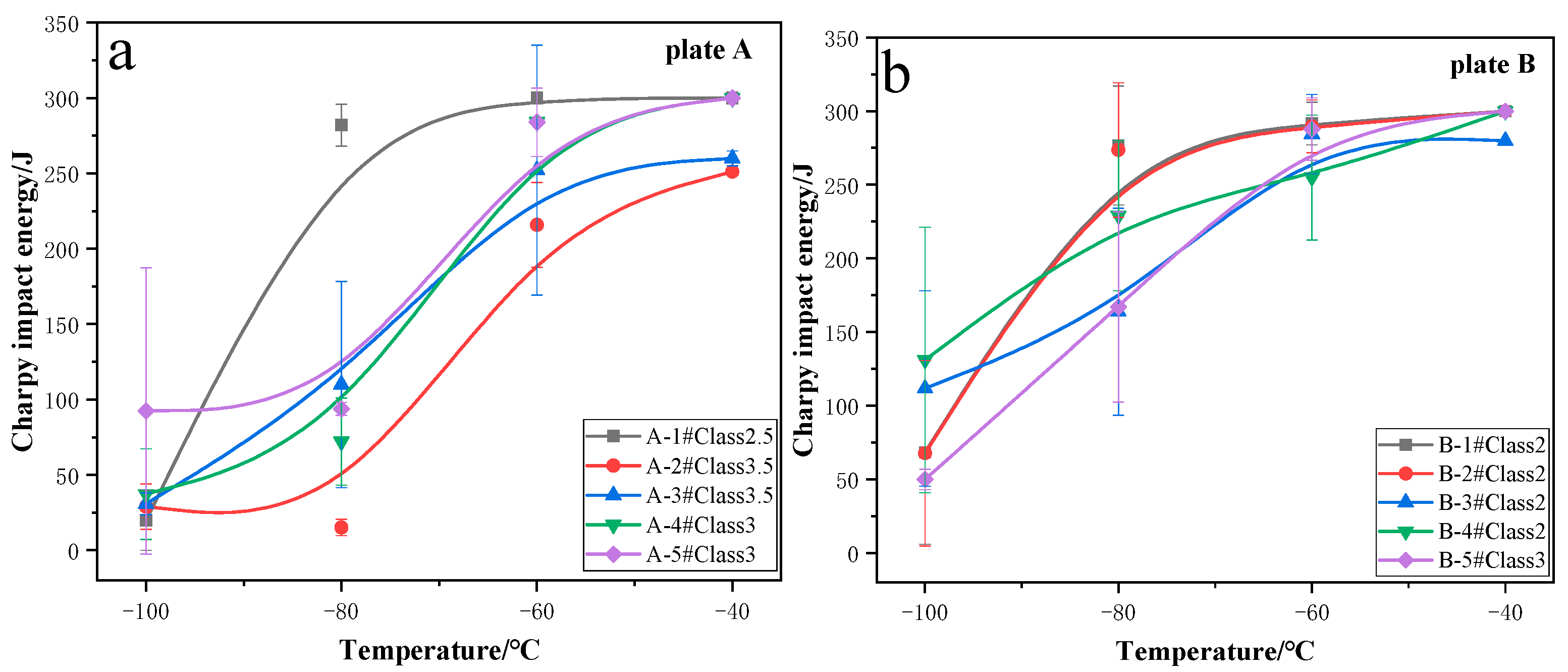
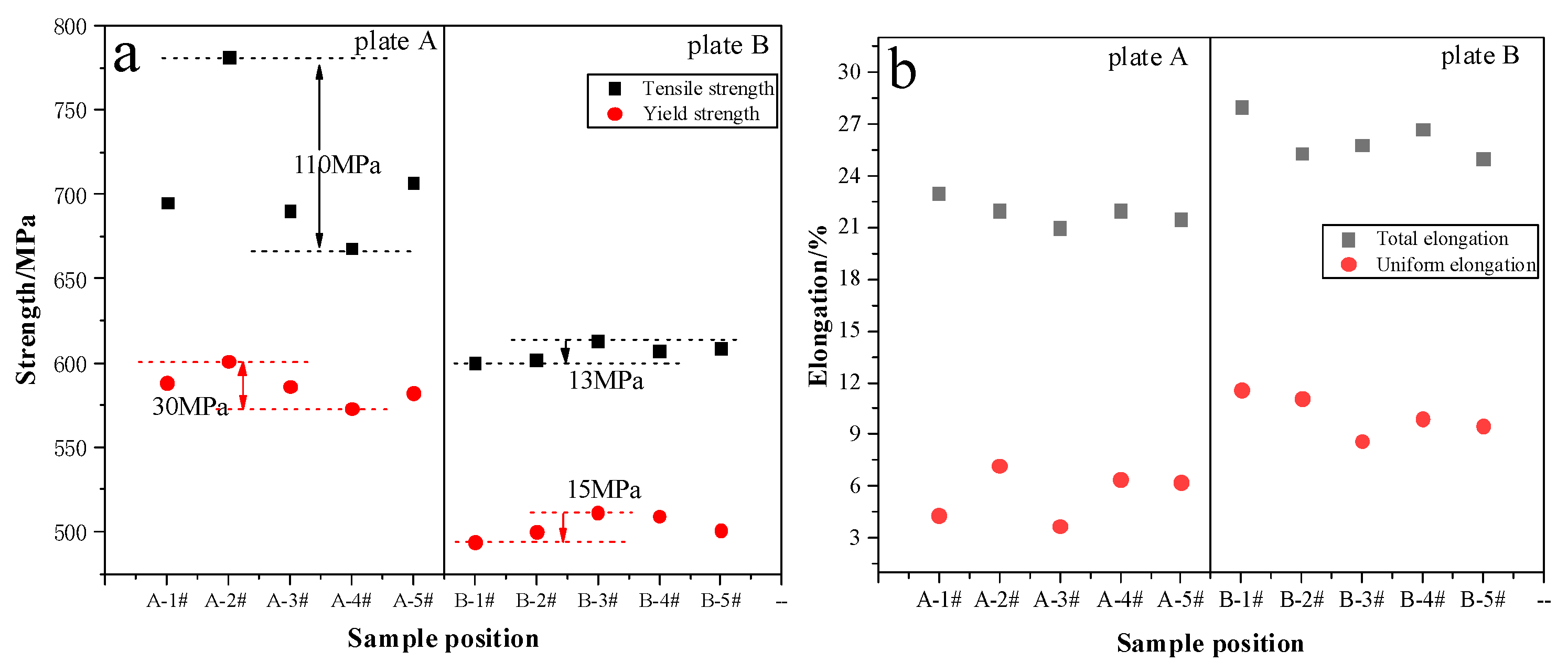
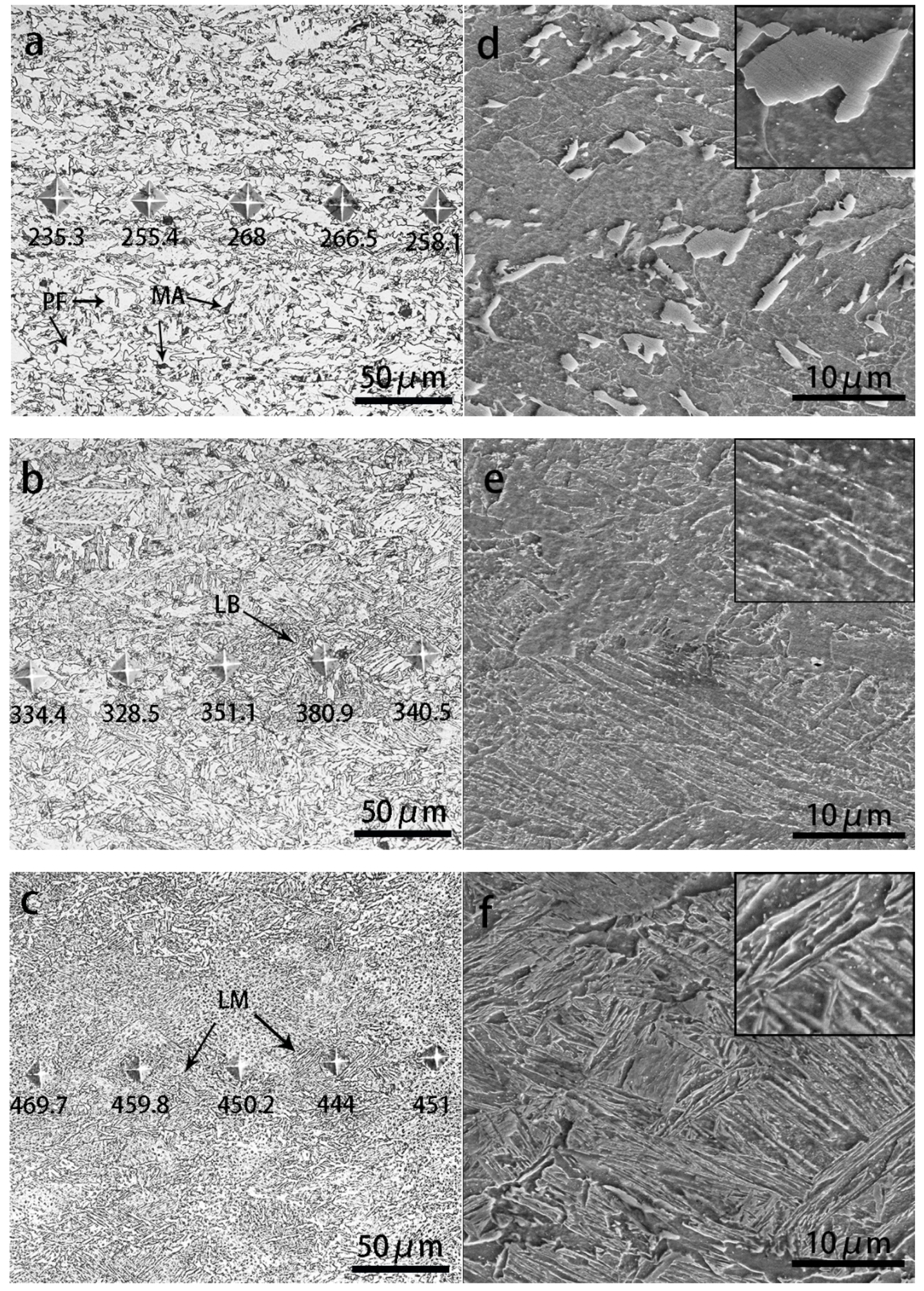
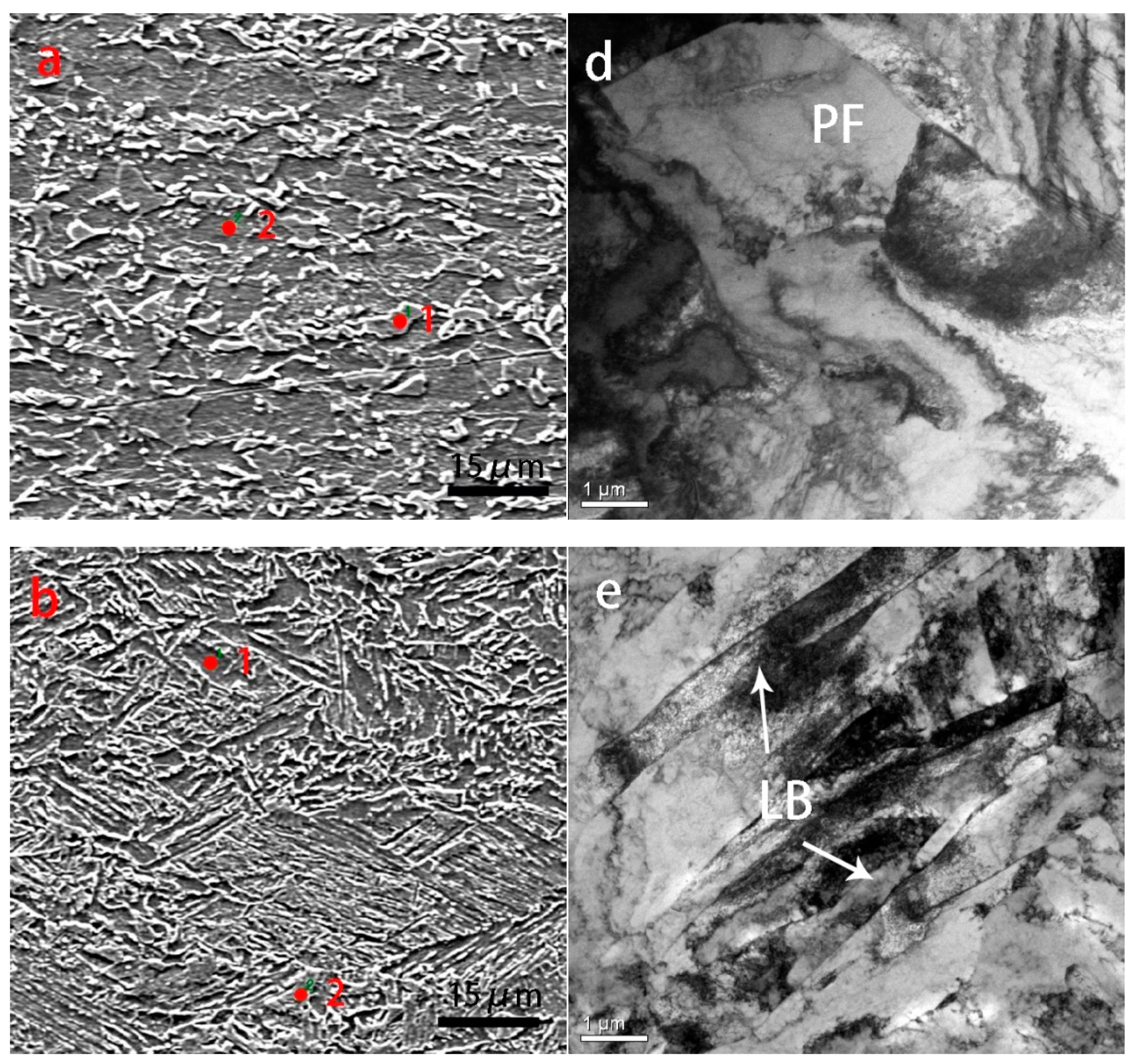

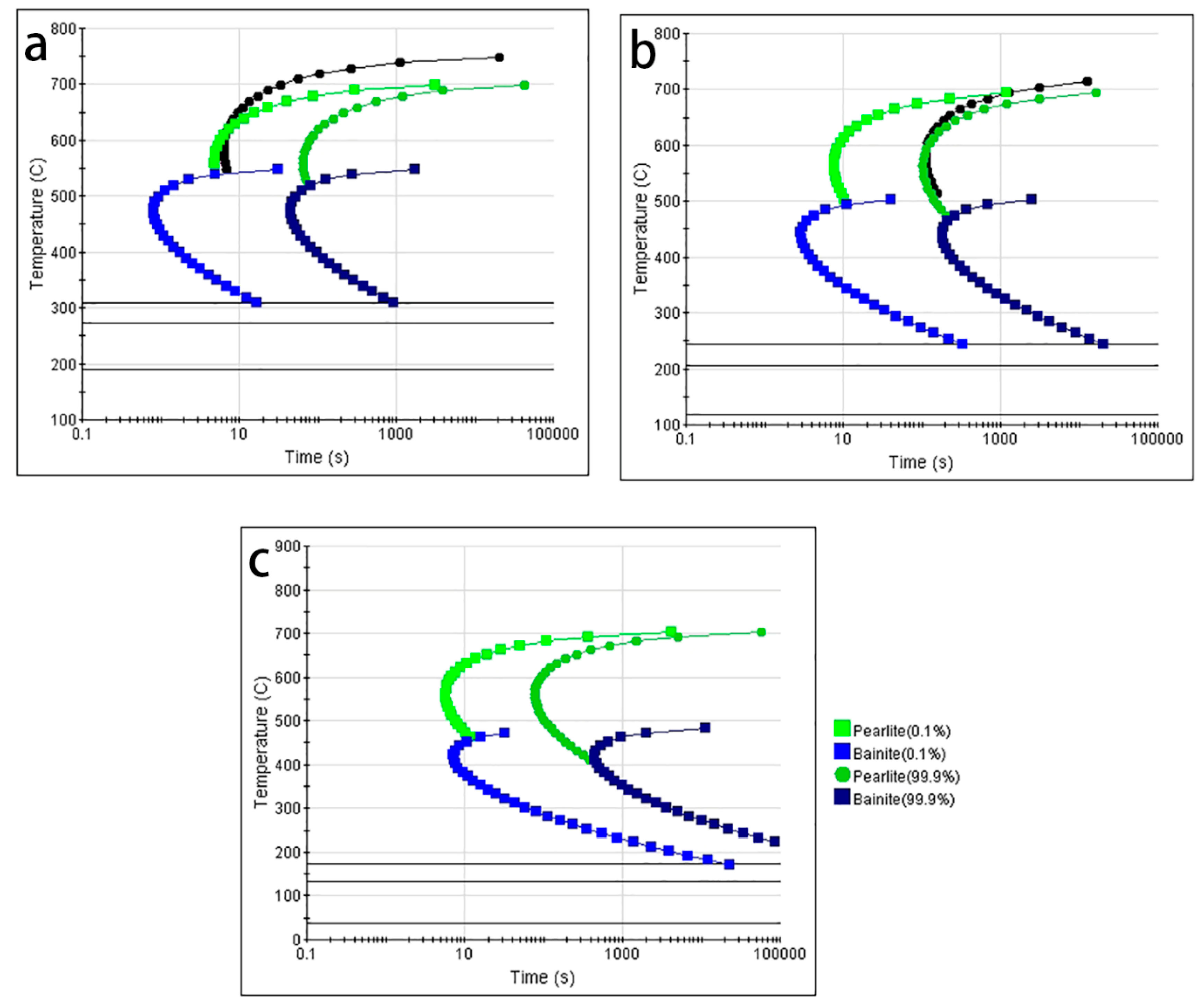
| Slab | 1# | 2# | 3# | 4# | 5# |
|---|---|---|---|---|---|
| A | 2.5 | 3.5 | 3.5 | 3 | 3 |
| B | 2 | 2 | 2 | 2 | 3 |
| Position | C | Mn | Al | Si | Ti | Cr | Ni | Nb | Mo | |
|---|---|---|---|---|---|---|---|---|---|---|
| B-4# | point1 | 0.414 | 1.796 | 0.021 | 0.201 | 0.033 | 0.007 | 0.008 | 0.083 | - |
| point2 | 0.471 | 1.813 | 0.018 | 0.163 | 0.010 | 0.039 | - | 0.054 | 0.094 | |
| A-4# | point1 | 0.387 | 1.701 | 0.025 | 0.116 | 0.068 | - | - | 0.069 | - |
| point2 | 0.527 | 2.382 | 0.027 | 0.265 | - | 0.049 | 0.013 | 0.115 | 0.102 | |
| A-2# | point1 | 0.410 | 2.031 | 0.019 | 0.201 | 0.033 | 0.004 | - | - | 0.006 |
| point2 | 0.732 | 2.385 | 0.017 | 0.195 | 0.02 | 0.005 | - | 0.094 | 0.067 | |
© 2019 by the authors. Licensee MDPI, Basel, Switzerland. This article is an open access article distributed under the terms and conditions of the Creative Commons Attribution (CC BY) license (http://creativecommons.org/licenses/by/4.0/).
Share and Cite
Guo, F.; Liu, W.; Wang, X.; Misra, R.D.K.; Shang, C. Controlling Variability in Mechanical Properties of Plates by Reducing Centerline Segregation to Meet Strain-Based Design of Pipeline Steel. Metals 2019, 9, 749. https://doi.org/10.3390/met9070749
Guo F, Liu W, Wang X, Misra RDK, Shang C. Controlling Variability in Mechanical Properties of Plates by Reducing Centerline Segregation to Meet Strain-Based Design of Pipeline Steel. Metals. 2019; 9(7):749. https://doi.org/10.3390/met9070749
Chicago/Turabian StyleGuo, Fujian, Wenle Liu, Xuelin Wang, R.D.K. Misra, and Chengjia Shang. 2019. "Controlling Variability in Mechanical Properties of Plates by Reducing Centerline Segregation to Meet Strain-Based Design of Pipeline Steel" Metals 9, no. 7: 749. https://doi.org/10.3390/met9070749
APA StyleGuo, F., Liu, W., Wang, X., Misra, R. D. K., & Shang, C. (2019). Controlling Variability in Mechanical Properties of Plates by Reducing Centerline Segregation to Meet Strain-Based Design of Pipeline Steel. Metals, 9(7), 749. https://doi.org/10.3390/met9070749







